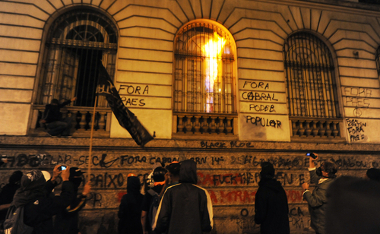The event known as "Fall of Constantinople”, which took place on May 29, 1453, is so important to world history that it was elected by historians of the nineteenth century as the one that ended the historical period of the Middle Ages and, therefore, began the Modern. Constantinople was conquered and subjugated by the Ottoman Sultan Mehmed II, who became known by the nickname “O Conquistador”. To understand this episode, it is necessary to dwell on some details of the context that involved it.
We know that Constantinople, before the fourth century d. C., it was called Byzantium and it was already a very important Greek city, founded in Anatolia, in the 7th century BC. Ç. This city became quite influential at the time of the EmpireAlexandrian, standing out as one of the great poles of Hellenistic culture. When, in the 1st century a. C., came the domain of EmpireRoman over the ancient Hellenistic territories, Byzantium became the central reference on the eastern side of the Empire – despite having suffered an attack from Rome in 196 BC. Ç. With successive crises in Rome, in the fourth century d. C, given the barbarian invasions, one of the most prominent political leaders of the time,
Constantine, changed the seat of the Roman Empire to Byzantium and, in 330, changed the name of the city to Constantinople.Constantine soon converted to Christianity, a religion that by this time had deep roots in the Anatolian region and throughout the Western Roman Empire. Gradually, the Byzantine Empire was characterized by the fusion between Greek (Hellenistic) and Judeo-Christian cultures and also became one of the most prosperous empires of the Middle Ages. Constantinople was the most coveted city to be harassed by hordes of barbarians, such as the Huns, who tried several times to breach its walls. The Western Christian kingdoms also had their estrangement from the Orthodox Byzantines. The high point of the divergences between West and East Europe at that time was the Fourth Crusade, from 1202, which resulted in the invasion and sacking of Constantinople and the creation of the so-called EmpireLatin, which was only dismantled by the Byzantines in 1261.
With these frequent attacks, Constantinople became increasingly isolated, with sparser territorial domains and weakened defenses. This vulnerability was put to good use by the most powerful empire that had risen in the Islamic world, the EmpireOttoman. The Ottomans were initially nomadic knights from central Asia who converted to Islam in the ninth century. They entered Europe through the Strait of Dardanelles in 1345 at the invitation of a Byzantine emperor, John V Palaeologist, that he needed warriors to fight a usurper. However, the Ottomans, in time, were not content with just receiving the pay given by the emperor, but began to conquer important cities under Byzantine influence, such as Gallipoli.
Do not stop now... There's more after the advertising ;)
João V Palaiologos came to offer western kings the end of Schism between the Catholic Church and the Orthodox if they helped him against the Ottomans. The problem was partially resolved after a negotiation with the sultan Murad I, in 1371, in which a suzerainty relationship was offered. In the decades that followed, relations between the Byzantines and the Ottomans became increasingly tense, given the space the latter had already conquered along the Balkan Peninsula. When Mehmet II he marched with his troops to Constantinople in 1453, unwilling to negotiate agreements as the sultans before him had done. His goal was clear: to take the city and make it the center of an even wider empire for the Ottomans, as historian Alan Palmer describes it:
Just after dawn on Tuesday, May 29, 1453, the Sultan's troops managed to penetrate through a small gate into the impregnable walls at Kerkoporta. By sundown, what was left of the sacked city was in his hands. Constantine XI Dragases, eighty-sixth emperor of the Greeks, died fighting in the narrow streets under the western walls. After more than eleven hundred years, there was not a single Christian emperor left in the East. [1]
The occupation of the city was quick and one of the sultan's first actions was to decharacterize the basilica of Hagia Sofia (Byzantine Christian Orthodox Church) and transform it into a Mosque, as Alan Palmer also attests:
When Sultan Mehmed II entered Constantinople at his gate that Tuesday afternoon, he went first to Saint Sofia, the church of Holy Wisdom, and placed the basilica under his protection before ordering it to be transformed into mosque. About sixty-five hours later, he returned to the basilica for Friday noon ritual prayers. The transformation was symbolic of the Conqueror's plans. The same happened when he insisted on investing in all solemnity a learned Orthodox monk on the patriarchal throne, then vacant. Mehmed aimed at continuity. For him, the “terrible event” was not the definitive end of an empire of world expression, nor a new beginning for the sultanate. He wanted to go beyond simply appropriating Christian altars to putting them at the service of Islam. [2]
This pretense of continuity of elements of the Byzantine culture would make it easier for Mehmed and his successors to conquer much of the Orthodox Christian world in that region. The Ottoman Empire, which would later change its name from Constantinople to Istanbul, reached its apogee in the next three centuries.
* Image credits: Shutterstock and Lestertair
By Me. Cláudio Fernandes


